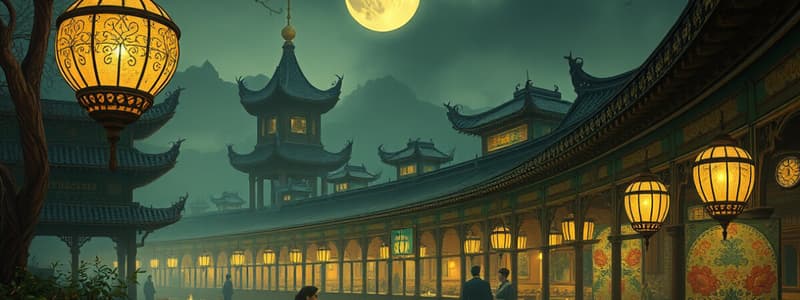Podcast
Questions and Answers
What primary theme is explored through the interactions of the travelers on the train?
What primary theme is explored through the interactions of the travelers on the train?
- The impact of technology on society
- The effects of colonialism on modern society
- The exploration of Western ideals in Eastern cultures
- The complexities of love and betrayal amidst war (correct)
How does Sternberg primarily develop character backstories in the film?
How does Sternberg primarily develop character backstories in the film?
- Using external narration to guide character history
- Employing non-linear storytelling with flashbacks (correct)
- Through extensive monologues focusing on past events
- Incorporating diary entries and letters
Which characteristic best describes the cinematographic style utilized in the film?
Which characteristic best describes the cinematographic style utilized in the film?
- A random assortment of camera angles for dynamism
- Continuous shot techniques to maintain realism
- High-contrast black-and-white cinematography with shadows (correct)
- Bright, vibrant colors to convey emotions
What metaphor does the train represent within the film's narrative?
What metaphor does the train represent within the film's narrative?
Which character primarily embodies the moral conflicts during the Chinese Civil War?
Which character primarily embodies the moral conflicts during the Chinese Civil War?
In what way does the film challenge colonial attitudes?
In what way does the film challenge colonial attitudes?
What directorial technique does Sternberg use to enhance emotional impact in scenes?
What directorial technique does Sternberg use to enhance emotional impact in scenes?
What is a significant aspect of character evolution in the film?
What is a significant aspect of character evolution in the film?
Flashcards are hidden until you start studying
Study Notes
Film Analysis
- Release Year: 1932
- Director: Josef von Sternberg
- Genre: Drama, Romance, Adventure
- Plot Summary: Set during the Chinese Civil War, the film follows a group of travelers on a train journey from Peking to Shanghai, highlighting their backgrounds and relationships amidst political tension.
- Key Themes:
- Love and betrayal
- The impact of war on personal lives
- Cultural encounters and conflicts
Directorial Style
- Sternberg's Aesthetic:
- Emphasis on visual composition and theatricality.
- Utilizes deep focus and elaborate set designs to create a mood.
- Strong use of lighting to enhance characters' emotions and create atmosphere.
- Narrative Techniques:
- Non-linear storytelling with flashbacks to develop character backstories.
- Dialogue-driven scenes that reveal character motivations and conflicts.
Character Development
- Main Characters:
- Shanghai Lily (Marlene Dietrich): A complex femme fatale torn between her past and present.
- Dr. Chang (Warner Oland): Represents the moral conflict and cultural tensions during the era.
- Other Passengers: Each character reflects different aspects of society and cultural heritage.
- Character Arcs:
- Characters evolve through interactions, revealing deeper layers as the story progresses.
- Focus on internal struggles and transformation influenced by external circumstances.
Cinematography
- Visual Style:
- Rich, high-contrast black-and-white cinematography.
- Use of shadows and silhouettes to emphasize mood and tension.
- Camera Techniques:
- Balanced framing and strategic angles to enhance storytelling.
- Slow pans and close-ups to capture emotional nuances in characters.
- Symbolism:
- Train as a metaphor for the journey of life and societal change.
Cultural Representation
- Cultural Context:
- Depicts the intersection of Western and Eastern cultures during a time of upheaval.
- Challenges and critiques colonial attitudes, showcasing Chinese characters with depth.
- Stereotypes vs. Authentic Representation:
- Balance between traditional stereotypes and more nuanced portrayals.
- Acknowledges cultural richness while critiquing Western perceptions of the East.
- Historical Significance:
- Highlights the complexities of Chinese identity during the 1930s.
- Serves as a reflection on the broader implications of imperialism and cultural exchange.
Film Overview
- Released in 1932, showcasing the works of director Josef von Sternberg.
- Genre combines elements of drama, romance, and adventure.
- Set against the backdrop of the Chinese Civil War, the plot revolves around a train journey from Peking to Shanghai, exploring traveler relationships and their diverse backgrounds amidst political unrest.
Key Themes
- Love and betrayal navigate personal interactions amid external chaos.
- The narrative examines the profound effects of war on individual lives and relationships.
- Cultural encounters depict the conflicts and connections between different backgrounds.
Directorial Style
- Sternberg's aesthetic focuses on visual composition, emphasizing theatrical elements.
- Deep focus techniques and intricate set designs enhance the film's atmospheric mood.
- Employs strong lighting to highlight characters' emotional states.
Narrative Techniques
- Features non-linear storytelling, utilizing flashbacks to enrich character development.
- Prioritizes dialogue-driven scenes to unpack character motivations and interpersonal conflicts.
Character Development
- Shanghai Lily, played by Marlene Dietrich, embodies a complex femme fatale navigating her past and present.
- Dr. Chang symbolizes the moral dilemmas and cultural tensions of the time.
- Minor characters represent diverse societal facets, each reflecting unique cultural heritages.
- Character arcs evolve through interactions, revealing layers influenced by external circumstances, showcasing internal struggles and transformations.
Cinematography
- High-contrast black-and-white cinematography creates a rich visual style.
- Shadows and silhouettes enhance mood and tension throughout the film.
- Balanced framing and strategic camera angles aid in storytelling, with slow pans and close-ups capturing emotional intricacies.
Symbolism
- The train symbolizes the journey of life and societal transformation.
Cultural Representation
- The film illustrates the fusion of Western and Eastern cultures during a period of turmoil.
- Analyzes colonial attitudes, allowing for complex portrayals of Chinese characters.
- Addresses the tension between stereotypes and authentic representation, emphasizing cultural depth while critiquing Western viewpoints.
Historical Significance
- Reflects on the complex identity of Chinese society during the 1930s.
- Engages with themes of imperialism and the nuances of cultural exchange in a global context.
Studying That Suits You
Use AI to generate personalized quizzes and flashcards to suit your learning preferences.




